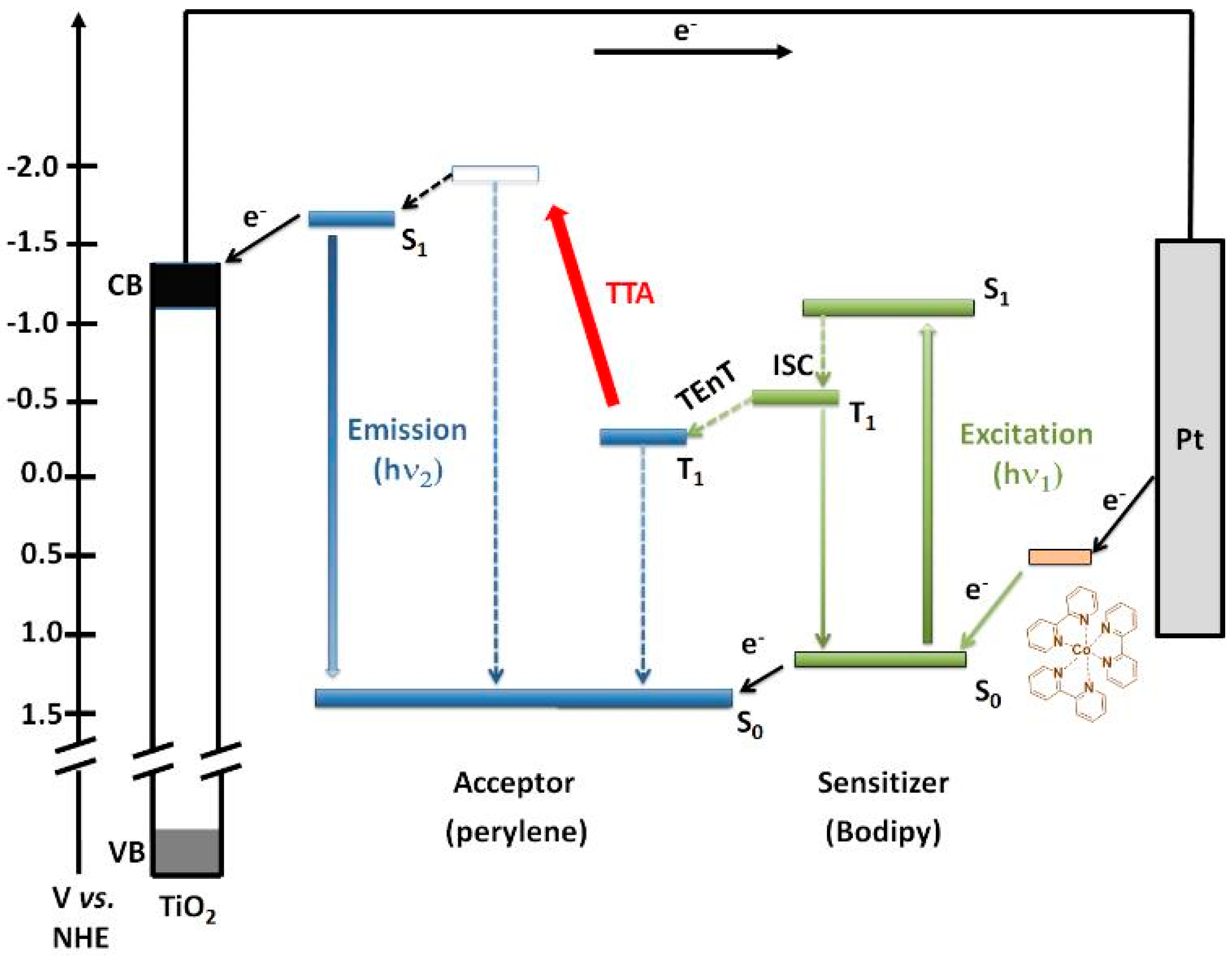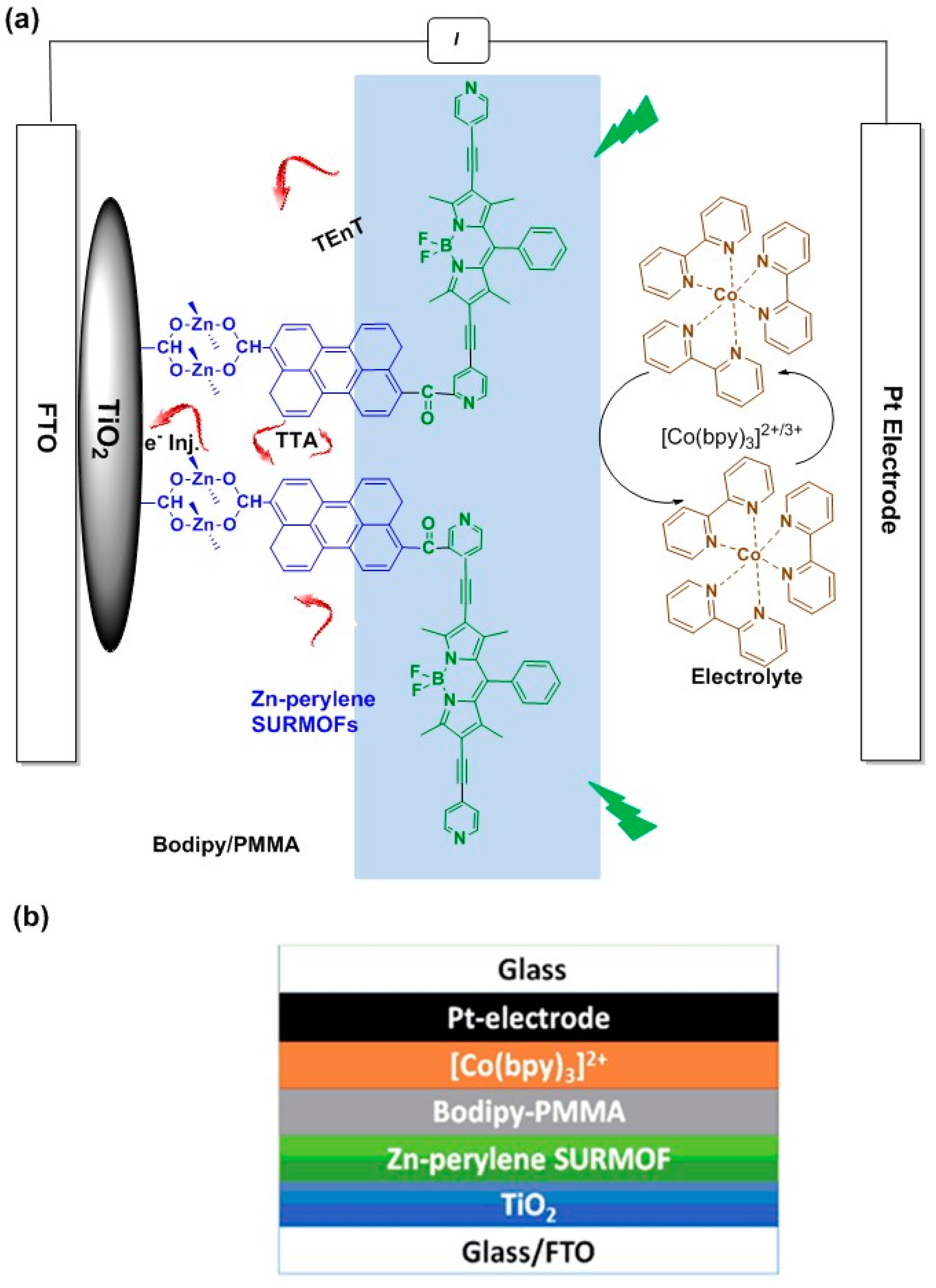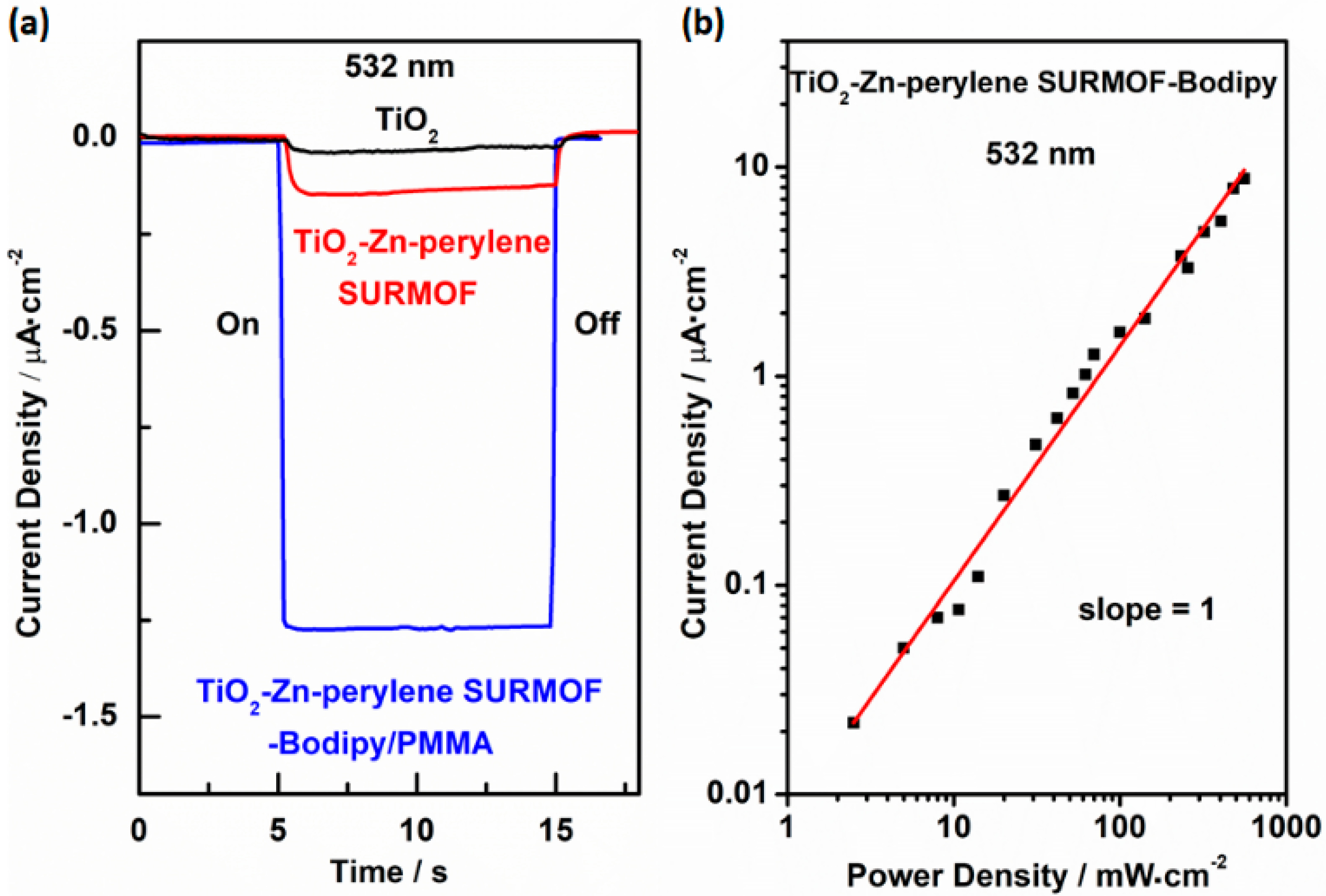Metal–Organic Framework Thin Film-Based Dye Sensitized Solar Cells with Enhanced Photocurrent
Abstract
1. Introduction
2. Results and Discussions
3. Conclusions
Supplementary Materials
Author Contributions
Funding
Acknowledgments
Conflicts of Interest
References
- Hill, S.P.; Banerjee, T.; Dilbeck, T.; Hanson, K. Photon upconversion and photocurrent generation via self-assembly at organic-inorganic interfaces. J. Phys. Chem. Lett. 2015, 6, 4510–4517. [Google Scholar] [CrossRef] [PubMed]
- Hill, S.P.; Dilbeck, T.; Baduell, E.; Hanson, K. Integrated Photon Upconversion Solar Cell via Molecular Self-Assembled Bilayers. ACS Energy Lett. 2016, 1, 3–8. [Google Scholar] [CrossRef]
- Simpson, C.; Clarke, T.M.; MacQueen, R.W.; Cheng, Y.Y.; Trevitt, A.J.; Mozer, A.J.; Wagner, P.; Schmidt, T.W.; Nattestad, A. An intermediate band dye-sensitised solar cell using triplet–triplet annihilation. Phys. Chem. Chem. Phys. 2015, 17, 24826–24830. [Google Scholar] [CrossRef] [PubMed]
- Shockley, W.; Queisser, H.J. Detailed balance limit of efficiency of p-n junction solar cells. J. Appl. Phys. 1961, 32, 510–519. [Google Scholar] [CrossRef]
- Dilbeck, T.; Wang, J.C.; Zhou, Y.; Olsson, A.; Sykora, M.; Hanson, K. Elucidating the Energy- and Electron-Transfer Dynamics of Photon Upconversion in Self-Assembled Bilayers. J. Phys. Chem. C 2017, 121, 19690–19698. [Google Scholar] [CrossRef]
- Wang, Z.; Knebel, A.; Grosjean, S.; Wagner, D.; Bräse, S.; Wöll, C.; Caro, J.; Heinke, L. Tunable molecular separation by nanoporous membranes. Nat. Commun. 2016, 7, 13872–13879. [Google Scholar] [CrossRef] [PubMed]
- Wu, G.; Huang, J.; Zang, Y.; He, J.; Xu, G. Porous Field-Effect Transistors Based on a Semiconductive Metal-Organic Framework. J. Am. Chem. Soc. 2016, 1360–1363. [Google Scholar] [CrossRef] [PubMed]
- Liu, H.L.; Chang, L.N.; Chen, L.Y.; Li, Y.W. Nanocomposites of Platinum/Metal-Organic Frameworks Coated with Metal-Organic Frameworks with Remarkably Enhanced Chemoselectivity for Cinnamaldehyde Hydrogenation. Chemcatchem 2016, 8, 946–951. [Google Scholar] [CrossRef]
- Wang, Z.B.; Nminibapiel, D.; Shrestha, P.; Liu, J.X.; Guo, W.; Weidler, P.G.; Baumgart, H.; Wöll, C.; Redel, E. Resistive Switching Nanodevices Based on Metal-Organic Frameworks. Chemnanomat 2016, 2, 67–73. [Google Scholar] [CrossRef]
- Kornienko, N.; Zhao, Y.; Kley, C.S.; Zhu, C.; Kim, D.; Lin, S.; Chang, C.J.; Yaghi, O.M.; Yang, P. Metal-organic frameworks for electrocatalytic reduction of carbon dioxide. J. Am. Chem. Soc. 2015, 137, 14129–14135. [Google Scholar] [CrossRef] [PubMed]
- Choi, K.M.; Kim, D.; Rungtaweevoranit, B.; Trickett, C.A.; Barmanbek, J.T.D.; Alshammari, A.S.; Yang, P.; Yaghi, O.M. Plasmon-Enhanced Photocatalytic CO2 Conversion within Metal-Organic Frameworks under Visible Light. J. Am. Chem. Soc. 2017, 139, 356–362. [Google Scholar] [CrossRef] [PubMed]
- Ye, L.; Liu, J.; Gao, Y.; Gong, C.; Addicoat, M.; Heine, T.; Wöll, C.; Sun, L. Highly oriented MOF thin film-based electrocatalytic device for the reduction of CO2 to CO exhibiting high faradaic efficiency. J. Mater. Chem. A 2016, 4, 15320–15326. [Google Scholar] [CrossRef]
- Wang, M.; Liu, J.; Guo, C.; Gao, X.; Gong, C.; Wang, Y.; Liu, B.; Li, X.; Gurzadyan, G.G.; Sun, L. Metal-organic framework (ZIF-67) as efficient cocatalyst for photocatalytic reduction of CO2: The role of morphology effect. J. Mater. Chem. A 2018, 6, 4768–4775. [Google Scholar] [CrossRef]
- Miner, E.M.; Dincă, M. Metal-organic frameworks: Evolved oxygen evolution catalysts. Nat. Energy 2016, 1, 16186. [Google Scholar] [CrossRef]
- Hod, I.; Deria, P.; Bury, W.; Mondloch, J.E.; Kung, C.W.; So, M.; Sampson, M.D.; Peters, A.W.; Kubiak, C.P.; Farha, O.K.; et al. A porous proton-relaying metal-organic framework material that accelerates electrochemical hydrogen evolution. Nat. Commun. 2015, 6, 8304–8313. [Google Scholar] [CrossRef] [PubMed]
- Liu, J.X.; Zhou, W.C.; Liu, J.X.; Howard, I.; Kilibarda, G.; Schlabach, S.; Coupry, D.; Addicoat, M.; Yoneda, S.; Tsutsui, Y.; et al. Photoinduced Charge-Carrier Generation in Epitaxial MOF Thin Films: High Efficiency as a Result of an Indirect Electronic Band Gap? Angew. Chem. Int. Ed. 2015, 54, 7441–7445. [Google Scholar] [CrossRef] [PubMed]
- Liu, J.X.; Zhou, W.C.; Liu, J.X.; Fujimori, Y.; Higashino, T.; Imahori, H.; Jiang, X.; Zhao, J.J.; Sakurai, T.; Hattori, Y.; et al. A new class of epitaxial porphyrin metal-organic framework thin films with extremely high photocarrier generation efficiency: promising materials for all-solid-state solar cells. J. Mater. Chem. A 2016, 4, 12739–12747. [Google Scholar] [CrossRef]
- Ahrenholtz, S.R.; Epley, C.C.; Morris, A.J. Solvothermal Preparation of an Electrocatalytic Metalloporphyrin MOF Thin Film and its Redox Hopping Charge-Transfer Mechanism. J. Am. Chem. Soc. 2014, 136, 2464–2472. [Google Scholar] [CrossRef] [PubMed]
- Ahmad, S.; Liu, J.; Gong, C.; Zhao, J.; Sun, L. Photon Up-Conversion via Epitaxial Surface-Supported Metal–Organic Framework Thin Films with Enhanced Photocurrent. ACS Appl. Energy Mater. 2018, 1, 249–253. [Google Scholar] [CrossRef]
- Oldenburg, M.; Turshatov, A.; Busko, D.; Wollgarten, S.; Adams, M.; Baroni, N.; Welle, A.; Redel, E.; Woll, C.; Richards, B.S.; et al. Photon Upconversion at Crystalline Organic-Organic Heterojunctions. Adv. Mater. 2016, 28, 8477–8482. [Google Scholar] [CrossRef] [PubMed]
- Simon, Y.C.; Weder, C. Low-power photon upconversion through triplet–triplet annihilation in polymers. J. Mater. Chem. 2012, 22, 20817–20830. [Google Scholar] [CrossRef]
- Gray, V.; Dzebo, D.; Abrahamsson, M.; Albinsson, B.; Moth-Poulsen, K. Triplet–triplet annihilation photon-upconversion: Towards solar energy applications. Phys. Chem. Chem. Phys. 2014, 16, 10345–10352. [Google Scholar] [CrossRef] [PubMed]
- Svagan, A.J.; Busko, D.; Avlasevich, Y.; Glasser, G.; Baluschev, S.; Landfester, K. Photon energy upconverting nanopaper: A bioinspired oxygen protection strategy. ACS Nano 2014, 8, 8198–8207. [Google Scholar] [CrossRef] [PubMed]
- Wang, J.C.; Hill, S.P.; Dilbeck, T.; Ogunsolu, O.O.; Banerjee, T.; Hanson, K. Multimolecular assemblies on high surface area metal oxides and their role in interfacial energy and electron transfer. Chem. Soc. Rev. 2018, 47, 104–148. [Google Scholar] [CrossRef] [PubMed]
- Wu, W.H.; Guo, H.M.; Wu, W.T.; Ji, S.M.; Zhao, J.Z. Organic Triplet Sensitizer Library Derived from a Single Chromophore (BODIPY) with Long-Lived Triplet Excited State for Triplet–triplet Annihilation Based Upconversion. J. Org. Chem. 2011, 76, 7056–7064. [Google Scholar] [CrossRef] [PubMed]
- Chen, Y.H.; Zhao, J.Z.; Xie, L.J.; Guo, H.M.; Li, Q.T. Thienyl-substituted BODIPYs with strong visible light-absorption and long-lived triplet excited states as organic triplet sensitizers for triplet–triplet annihilation upconversion. RSC Adv. 2012, 2, 3942–3953. [Google Scholar] [CrossRef]
- Zhang, C.S.; Zhao, J.Z.; Wu, S.; Wang, Z.L.; Wu, W.H.; Ma, J.; Guo, S.; Huang, L. Intramolecular RET Enhanced Visible Light-Absorbing Bodipy Organic Triplet Photosensitizers and Application in Photooxidation and Triplet–triplet Annihilation Upconversion. J. Am. Chem. Soc. 2013, 135, 10566–10578. [Google Scholar] [CrossRef] [PubMed]
- Rautela, R.; Joshi, N.K.; Novakovic, S.; Wong, W.W.H.; White, J.M.; Ghiggino, K.P.; Paige, M.F.; Steer, R.P. Determinants of the efficiency of photon upconversion by triplet–triplet annihilation in the solid state: zinc porphyrin derivatives in PVA. Phys. Chem. Chem Phys. 2017, 19, 23471–23482. [Google Scholar] [CrossRef] [PubMed]
- Lee, C.Y.; Farha, O.K.; Hong, B.J.; Sarjeant, A.A.; Nguyen, S.T.; Hupp, J.T. Light-Harvesting Metal-Organic Frameworks (MOFs): Efficient Strut-to-Strut Energy Transfer in Bodipy and Porphyrin-Based MOFs. J. Am. Chem. Soc. 2011, 133, 15858–15861. [Google Scholar] [CrossRef] [PubMed]
- Joblin, C.; Salama, F.; Allamandola, L. Absorption and emission spectroscopy of perylene (C20H12) isolated in Ne, Ar, and N2 matrices. J. Chem. Phys. 1999, 110, 7287–7297. [Google Scholar] [CrossRef]
- Summers, G.H.; Lefebvre, J.F.; Black, F.A.; Davies, E.S.; Gibson, E.A.; Pullerits, T.; Wood, C.J.; Zidek, K. Design and characterisation of bodipy sensitizers for dye-sensitized NiO solar cells. Phys. Chem. Chem. Phys. 2016, 18, 1059–1070. [Google Scholar] [CrossRef] [PubMed]
- Ahmed, R.M. Optical Study on Poly(methylmethacrylate)/Poly(vinyl acetate) Blends. Int. J. Photoenergy 2009, 2009, 1–7. [Google Scholar] [CrossRef]
- Karagiaridi, O.; Bury, W.; Mondloch, J.E.; Hupp, J.T.; Farha, O.K. Solvent-assisted linker exchange: an alternative to the de novo synthesis of unattainable metal-organic frameworks. Angew. Chem. 2014, 53, 4530–4540. [Google Scholar] [CrossRef] [PubMed]
- Cheng, Y.Y.; Khoury, T.; Clady, R.G.C.R.; Tayebjee, M.J.Y.; Ekins-Daukes, N.J.; Crossley, M.J.; Schmidt, T.W. On the efficiency limit of triplet–triplet annihilation for photochemical upconversion. Phys. Chem. Chem. Phys. 2010, 12, 66–71. [Google Scholar] [CrossRef] [PubMed]




© 2018 by the authors. Licensee MDPI, Basel, Switzerland. This article is an open access article distributed under the terms and conditions of the Creative Commons Attribution (CC BY) license (http://creativecommons.org/licenses/by/4.0/).
Share and Cite
Ahmad, S.; Liu, J.; Ji, W.; Sun, L. Metal–Organic Framework Thin Film-Based Dye Sensitized Solar Cells with Enhanced Photocurrent. Materials 2018, 11, 1868. https://doi.org/10.3390/ma11101868
Ahmad S, Liu J, Ji W, Sun L. Metal–Organic Framework Thin Film-Based Dye Sensitized Solar Cells with Enhanced Photocurrent. Materials. 2018; 11(10):1868. https://doi.org/10.3390/ma11101868
Chicago/Turabian StyleAhmad, Shargeel, Jinxuan Liu, Wei Ji, and Licheng Sun. 2018. "Metal–Organic Framework Thin Film-Based Dye Sensitized Solar Cells with Enhanced Photocurrent" Materials 11, no. 10: 1868. https://doi.org/10.3390/ma11101868
APA StyleAhmad, S., Liu, J., Ji, W., & Sun, L. (2018). Metal–Organic Framework Thin Film-Based Dye Sensitized Solar Cells with Enhanced Photocurrent. Materials, 11(10), 1868. https://doi.org/10.3390/ma11101868




